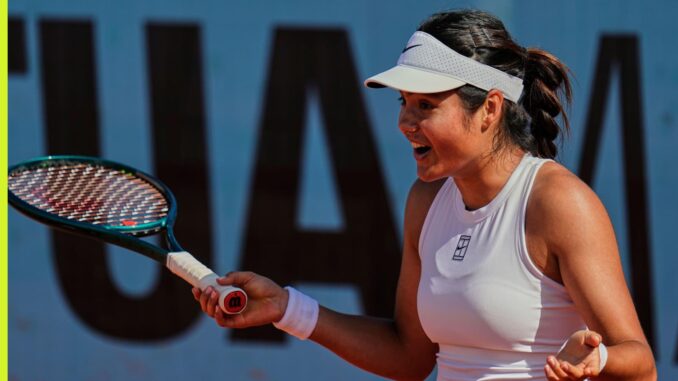
In the unforgiving crucible of professional tennis, where dreams soar and collapse in a single rally, the stories of Bianca Andreescu and Emma Raducanu stand as electrifying testaments to talent and tenacity. Both burst onto the global stage as teenage prodigies, seizing the US Open crown in moments that felt like destiny. Andreescu’s 2019 triumph over Serena Williams, a straight-sets masterclass that shook Flushing Meadows, marked her as Canada’s new hope. Two years later, in 2021, Raducanu scripted history as the first qualifier to claim a Grand Slam, her flawless 10-match run—without dropping a set—igniting a frenzy in Britain and beyond. These victories were more than titles; they were coronations, thrusting both into a spotlight that brought fame, fortune, and unrelenting pressure. But what followed was a parallel saga of injuries, doubts, and the crushing weight of expectations that tests even the fiercest spirits.
For Andreescu, the high of reaching world No. 4 after her US Open win was a fleeting summit. A cascade of injuries—a torn meniscus among them—halted her momentum, forcing her off the tour for long stretches. The physical pain was only half the battle; the mental toll was crushing. She stepped away for mental health breaks, grappled with thoughts of retirement, and watched her ranking slide to No. 177 by October 2025. Reflecting on her post-US Open whirlwind, she recently admitted, “I definitely feel I could have done with a little more guidance after the US Open win and maybe I would have done things a little differently.” At just 19, she was unprepared for the media blitz, endorsement deals, and the grind of a pro circuit that offered little room for error. The weight of sudden stardom, she confessed, was a lesson learned the hard way.
Raducanu’s journey echoes Andreescu’s, but with its own distinct scars. Her 2021 fairy tale—10 straight wins, all in straight sets—catapulted her to global fame, but the aftermath was brutal. Surgeries in 2023 decimated her season, and her ranking plummeted to No. 289. Off the court, the demands were relentless: lucrative sponsorships, a media spotlight that dissected her every move, and the burden of being Britain’s tennis beacon in a nation hungry for heroes. Andreescu, seeing her own struggles reflected, offered heartfelt empathy: “Coming from Britain, she’s definitely had it tougher than me. The fame, the pressure from sponsors… that must have been a lot of pressure.” Yet, she also sees promise in Raducanu’s fightback, noting, “It’s great to see Emma coming back to the top and she is playing some great tennis at the moment. She was close to beating Pegula last week, so that shows the level she is playing at.”
As 2025 nears its close, both players are clawing their way back on a WTA Tour that’s fiercer than ever. The rise of powerhouses like Iga Swiatek and Aryna Sabalenka has raised the bar, with matches demanding physical and mental endurance amid a landscape where social media and branding compete with forehands for attention. Raducanu, now ranked No. 30, is rediscovering her 2021 spark. Semifinals in Washington, deep runs at the Miami Masters, and a refined serve under coach Francisco Roig signal her resurgence. Her sights are set on a 2026 Australian Open seeding, a goal she’s tackling with discipline. “Being seeded for Australia is a big target for me over the next few weeks,” she said, emphasizing her commitment to staying true to her game. A recent withdrawal in Wuhan due to heat-induced dizziness was a setback, but her steady climb through 2025 shows her resolve.
Andreescu, too, is rebuilding, treating events like the Wuhan Open as a springboard for 2026. A gut-wrenching loss in singles qualifying to Anastasia Zakharova, despite serving for the match, stung, but she’s finding joy in doubles and soaking in China’s vibrant energy. “I love coming here. It’s always a fun experience and a little different than what we are used to,” she shared, relishing local flavors and the chance to compete. Her agent’s nudges to amplify her social media presence—“it feels like a full-time job”—are a distraction she’s learning to manage. Her optimism shines through: “I’m happy to be back on court and competing again. I kinda know I will be back competing at the top again. It’s just a matter of time.”
Their intertwined paths reveal a profound truth about tennis: early triumphs can be both a launchpad and a burden, fueling growth while flirting with burnout. Both have embraced mental fortitude, with Raducanu carving out time to shield her focus from off-court noise and Andreescu channeling past regrets into renewed hunger. Their stories resonate beyond the baseline, inspiring players and fans alike with the promise that from the depths of adversity, a comeback is always within reach. As the 2026 Australian Open looms, the tennis world watches, breathless, to see if these former champions can transform their struggles into triumphs, their echoes of pain into anthems of victory.
Leave a Reply